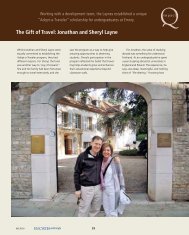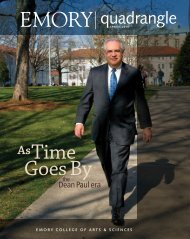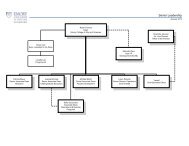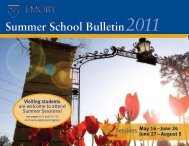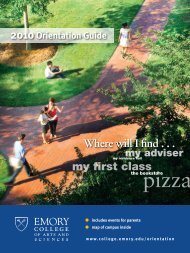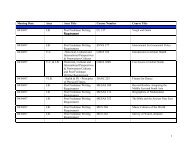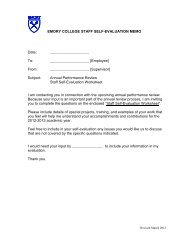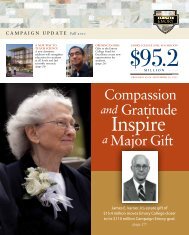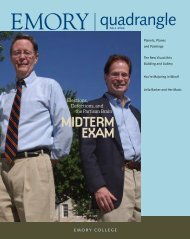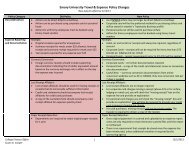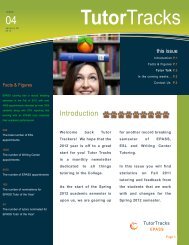quadrangle - Emory College - Emory University
quadrangle - Emory College - Emory University
quadrangle - Emory College - Emory University
You also want an ePaper? Increase the reach of your titles
YUMPU automatically turns print PDFs into web optimized ePapers that Google loves.
editor’s le t te r<br />
kudos<br />
impact<br />
attract “smart, curious, creative and socially engaged students, who<br />
will grow to become lifelong learners and responsible citizens.” We’re<br />
committed, too, to recruiting and retaining superb scholar-teachers<br />
and supporting our strong departments and programs.<br />
One measure of our success in these efforts is the National<br />
Survey of Students bookmarks (NSSE), which compiles data on teaching<br />
and learning at more than one thousand colleges. The 2006 survey<br />
brought some enlightening results: <strong>Emory</strong> <strong>College</strong> eagle students eye<br />
report higher levels of faculty interaction, and more academically<br />
challenging and enriching course work, than their peers<br />
at other schools. They also participate in far more community<br />
and volunteer work, study abroad nearly three times as often,<br />
and are twice as likely to collaborate with faculty on research<br />
outside course requirements.<br />
The comments of external review committees can be another<br />
useful yardstick. In the past two years, more than a dozen such<br />
committees—composed of faculty and administrators from across<br />
the nation—have scrutinized <strong>Emory</strong> <strong>College</strong> departments for<br />
flaws, virtues and opportunities to improve. Here’s what they said:<br />
“There is far more productive instructional and advising<br />
interaction between faculty and departmental majors than at<br />
many, if not most, peer research institutions.”<br />
“Students have enormous regard for their professors and see<br />
them as offering the best of what a liberal arts institution provides,<br />
informed by the scholarly rigor required at research institutions.”<br />
I could quote for pages: “A laudable emphasis on keeping class<br />
size limited. . . . Students rave about the attention and care of the<br />
professors. . . . A positive orientation toward undergraduate education<br />
on a level usually found in small liberal arts colleges.”<br />
We take pride in this kind of feedback, as we do in being recognized<br />
as a leader in environmentally friendly “green” facilities and<br />
other accolades. Meanwhile we keep an eye, like everyone else, on<br />
the annual lists. Maybe what’s needed is more open conversation<br />
about what colleges do and about the whole idea of ranking them<br />
like lawnmowers or cars. We should consider how much light<br />
any list can throw on the wonderful, complicated places where<br />
our brightest young people spend four important years. And we<br />
should thank all the dedicated researchers, teachers, students,<br />
staff and alumni who contribute their manifold talents to making<br />
<strong>Emory</strong> <strong>College</strong> special. That honor roll grows longer every year, and<br />
it’s one list I think we can all agree deserves our unflagging attention<br />
and highest regard.<br />
Robert A. Paul, PhD<br />
Dean of <strong>Emory</strong> <strong>College</strong><br />
I hope you’ve enjoyed the first three<br />
Quadrangles, and will enjoy this fourth, as much as I’ve<br />
liked putting them together. I remain amazed at the bonanza of<br />
material <strong>Emory</strong> offers—the <strong>College</strong> is full of more good people,<br />
places and ideas than a biannual publication can hope to plumb.<br />
Selection continues to be the challenge: how to suggest the breadth<br />
of teaching and research, innovation and tradition that defines<br />
<strong>Emory</strong> without skipping around like a stone on a pond. It’s a nice<br />
problem to have.<br />
This issue offers another range of voices from the ongoing<br />
<strong>College</strong> conversation: Dean Paul on the issue of ranking schools and,<br />
with three other <strong>College</strong> deans, on what they do and why; <strong>Emory</strong><br />
departments looking back and ahead while marking anniversaries;<br />
Hal Jacobs on being a freshman (again); wide-eyed reflections on<br />
caffeinated campus culture; and, as always, visits with students and<br />
faculty doing what they love.<br />
In my first letter two years ago, I encouraged you to let us<br />
know what you think of the magazine, and many of you have.<br />
I’ve been grateful for all the letters and comments, both criticism<br />
and praise. I hope you’ll continue. This time—in addition to any<br />
general remarks—I hope you will take a moment to think about<br />
your favorite (or most memorable) <strong>College</strong> professors, places,<br />
classes, events, jobs, rituals or moments. Send them to me by mail<br />
or email, short or long, and they might wind up incorporated into<br />
a future Quadrangle story.<br />
Thanks for reading.<br />
table of contents<br />
David Raney 99PHD<br />
Editor<br />
draney@emory.edu<br />
spring 2007



